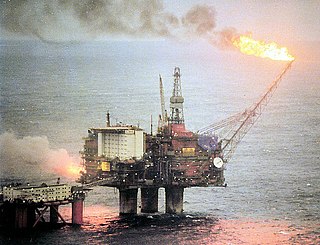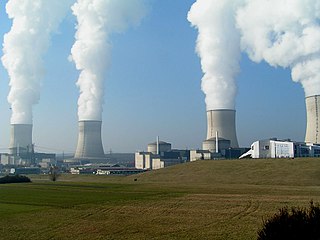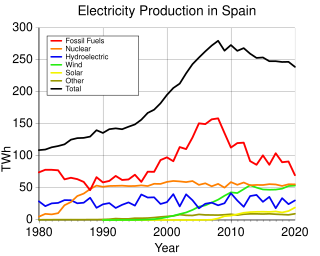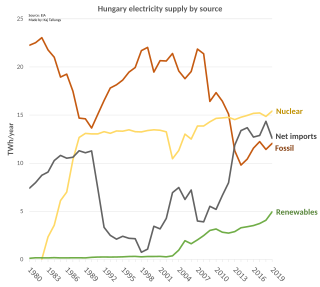
Denmark has considerable sources of oil and natural gas in the North Sea and ranked as number 32 in the world among net exporters of crude oil in 2008. Denmark expects to be self-sufficient with oil until 2050. However, gas resources are expected to decline, and production may decline below consumption in 2020, making imports necessary. Denmark imports around 12% of its energy.

Norway is a large energy producer, and one of the world's largest exporters of oil. Most of the electricity in the country is produced by hydroelectricity. Norway is one of the leading countries in the electrification of its transport sector, with the largest fleet of electric vehicles per capita in the world.

Ensuring adequate energy supply to sustain economic growth has been a core concern of the Chinese government since 1949. The country is the world's largest emitter of greenhouse gases, and coal in China is a major cause of global warming. However, from 2010 to 2015 China reduced energy consumption per unit of GDP by 18%, and CO2 emissions per unit of GDP by 20%. On a per-capita basis, it was the world's 51st largest emitter of greenhouse gases in 2016. China is also the world's largest renewable energy producer. China is the largest producer of hydroelectricity, solar power and wind power in the world. The energy policy of China is connected to its industrial policy. The goals of China's industrial policy dictate its energy needs.

Energy in Finland describes energy and electricity production, consumption and import in Finland. Energy policy of Finland describes the politics of Finland related to energy. Electricity sector in Finland is the main article of electricity in Finland.

Energy in Australia is the production in Australia of energy and electricity, for consumption or export. Energy policy of Australia describes the politics of Australia as it relates to energy.

Majority of electricity production in Sweden relies on hydro power and nuclear power. In 2008 the consumption of electricity in Sweden was 16018 kWh per capita, compared to EU average 7409 kWh per capita. Sweden has a national grid, which is part of the Synchronous grid of Northern Europe. A specialty of the Nordic energy market is the existence of so-called electricity price areas, which complicate the wholesale Nordic energy market.

The electricity sector in France is dominated by its nuclear power, which accounted for 71.7% of total production in 2018, while renewables and fossil fuels accounted for 21.3% and 7.1%, respectively. France has the largest share of nuclear electricity in the world, and together with renewable energy supplies, this has helped its grid achieve very low carbon intensity.
The environment of Luxembourg has been affected by the country' rapid population growth, its heavy road traffic and its lack of renewable energy resources.

The electricity sector in Spain describes electricity in Spain. In 2008, Spain consumed 88% of the average electricity consumption for a European Union 15 country. In 2009, Spain exported about 3% of the electricity it produced. The volume of renewable electricity produced in 2009 was 5% greater than in 2004, and accounted for about 26% of the electricity consumption. The share of nuclear power declined notably between 2004 and 2005. The volume of nuclear power per person has declined consistently during 2004–2009.

The total electricity consumption of the Netherlands in 2021 was 117 terawatt-hours (TWh). The consumption grew from 7 TWh in 1950 by an average of 4.5% per year. As of 2021, the main resources for electricity in the Netherlands are fossil fuels, such as natural gas and coal. In 2021, fossil fuels accounted for about 62% of the produced electricity. Renewable energy sources, such as biomass, wind power, and solar power, produce 38% of the total electricity. There is one nuclear plant in the Netherlands, in Borssele, which is responsible for about 3% of total generation. The majority of the electricity, more than 75%, is produced centrally by thermal and nuclear units.

The electricity sector in Belgium describes electricity in Belgium. Production by power source in 2009 was 53% nuclear, 40% fossil electricity and 7% renewable electricity. 2% of production was exported in 2009. In 2008 import was 11%. Belgium is highly nuclear dependent country where the share of renewable electricity has been low. The share of renewable electricity was about 2% in 2005. Plan for 2020 is wind 10.5 TWh (9.5%), biomass 11 TWh and PV 1 TWh.

The electricity sector in Switzerland relies mainly on hydroelectricity, since the Alps cover almost two-thirds of the country's land mass, providing many large mountain lakes and artificial reservoirs suited for hydro power. In addition, the water masses drained from the Swiss Alps are intensively used by run-of-the-river hydroelectricity (ROR). With 9,052 kWh per person in 2008, the country's electricity consumption is relatively high and was 22% above the European Union's average.

Energy policy of Belgium describes the politics of Belgium related to energy. Energy in Belgium describes energy and electricity production. consumption and import in Belgium. Electricity sector in Belgium is the main article of electricity in Belgium.

Energy in Sweden describes energy and electricity production, consumption and import in Sweden. Electricity sector in Sweden is the main article of electricity in Sweden. The Swedish climate bill of February 2017 aims to make Sweden carbon neutral by 2045. The Swedish target is to decline emission of climate gases 63% from 1990 to 2030 and international transportation excluding foreign flights 70%. By 2014 just over half of the country's total final energy consumption in electricity, heating and cooling and transport combined was provided by renewables, the highest share amongst the then 28 EU member countries. About a third of Sweden's electricity is generated by nuclear power. In generating a year's worth of this energy, Swedes generate about 4 tonnes of CO2 emissions each. Since 2010, sustainability measures have reduced total emissions even as the population has increased.

Energy in Portugal describes energy and electricity production, consumption and import in Portugal. Energy policy of Portugal will describe the politics of Portugal related to energy more in detail. Electricity sector in Portugal is the main article of electricity in Portugal.
Electricity in Cyprus is managed by the Electricity Authority of Cyprus. Power is primarily generated at three fuel oil-burning stations but the use of distributed renewable energy is expanding.

Energy in Hungary describes energy and electricity production, consumption and import in Hungary. Energy policy of Hungary describes the politics of Hungary related to energy.
Energy in Luxembourg describes energy and electricity production, consumption and import in Luxembourg. Energy policy of Luxembourg will describe the politics of Luxembourg related to energy in greater detail. Electricity sector in Luxembourg is the main article of electricity in Luxembourg.

Primary energy use in Slovakia was 194 TWh and 36 TWh per million inhabitants in 2009.
Climate change in Luxembourg discusses the climate change issues in Luxembourg.















